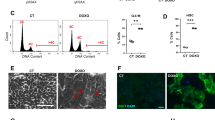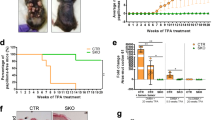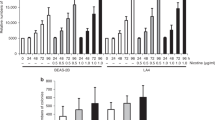Abstract
RESIDUAL DNA lesions in the template strand during replication may represent the ‘stumbling blocks’ responsible for mutagenesis and initiation of malignant transformation. The fraction of specific lesions which remains unexcised at the time of DNA replication is determined by their ‘excisability’1 in a particular tissue. Lesions which become refractory to excision and remain in the DNA over many generations, referred to as ‘persistent lesions’, may play a crucial role in the transformation process2–4. We have studied the ‘excisability’ and ‘persistence’ of the covalent DNA adducts produced in the epithelioid human alveolar tumour cell A549 (ref. 5) by benzo(a)pyrene (B(a)P)6, and found that the excisability of the covalent B(a)P–DNA adducts in A549 cells was poor and that a sizeable fraction of the lesions persisted over several generations. The poor repairability by excision of these and related lesions in human lung cells may represent a factor in lung carcinogenesis by polycyclic aromatic hydrocarbons.
This is a preview of subscription content, access via your institution
Access options
Subscribe to this journal
Receive 51 print issues and online access
$199.00 per year
only $3.90 per issue
Buy this article
- Purchase on Springer Link
- Instant access to full article PDF
Prices may be subject to local taxes which are calculated during checkout
Similar content being viewed by others
References
Cerutti, P. A. DNA Repair Mechanisms (ed. Hanawalt, P. C., Friedberg, E. C. & Fox, C. F.) (Academic, New York, in the press).
Westra, J., Kriek, E. & Hittenhausen, H. Chem.-Biol. Interact. 15, 149–164 (1976).
Goth, R. & Rajewski, M. Proc. natn. Acad. Sci. U.S.A. 71, 639–643 (1974).
Margison, G., Margison, J. & Montesano, R. Biochem. J. 105, 463–468 (1977).
Lieber, M., Smith, B., Szakal, A., Nelson-Rees, W. & Todaro, G. Int. J. Cancer 17, 62–70 (1976).
Shinohara, K. & Cerutti, P. Cancer Lett. 3, 303–309 (1977).
Polycyclic Hydrocarbons and Cancer (eds Gelboin, H. & Ts'o, P.) (Academic, New York, in the press).
Remsen, J., Jerina, D., Yagi, H. & Cerutti, P. Biochem. biophys. Res. Commun. 74, 934–940 (1977).
Cerutti, P., Sessions, F., Hariharan, P. & Lusby, A. Cancer Res. 38, 2118–2124 (1978).
Jahn, C. & Litman, B. Biochem. biophys. Res. Commun. 76, 534–540 (1977).
Shinohara, K. & Cerutti, P. Proc. natn. Acad. Sci. U.S.A. 74, 979–983 (1977).
Baird, W. & Diamond, L. Biochem. biophys. Res. Commun. 77, 162–167 (1977).
Söllner-Webb, B. & Felsenfeld, G. Biochemistry 13, 2915–2920 (1975).
Author information
Authors and Affiliations
Rights and permissions
About this article
Cite this article
FELDMAN, G., REMSEN, J., SHINOHARA, K. et al. Excisability and persistence of benzo(a)pyrene DNA adducts in epithelioid human lung cells. Nature 274, 796–798 (1978). https://doi.org/10.1038/274796a0
Received:
Accepted:
Issue Date:
DOI: https://doi.org/10.1038/274796a0
This article is cited by
-
Role of polycyclic aromatic hydrocarbons as a co-factor in human papillomavirus-mediated carcinogenesis
BMC Cancer (2019)
-
Covalent binding of BP-metabolites to DNA of cultured human hair follicle keratinocytes
Archives of Toxicology (1985)
-
Nucleic acid adducts of chemical carcinogens and mutagens
Archives of Toxicology (1983)
-
Differentiation of the mammary gland and susceptibility to carcinogenesis
Breast Cancer Research and Treatment (1982)
Comments
By submitting a comment you agree to abide by our Terms and Community Guidelines. If you find something abusive or that does not comply with our terms or guidelines please flag it as inappropriate.



